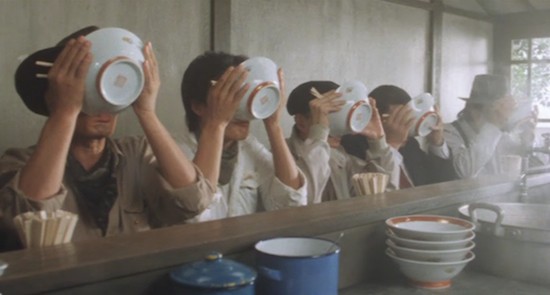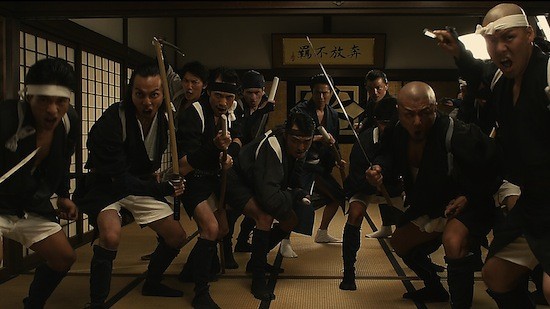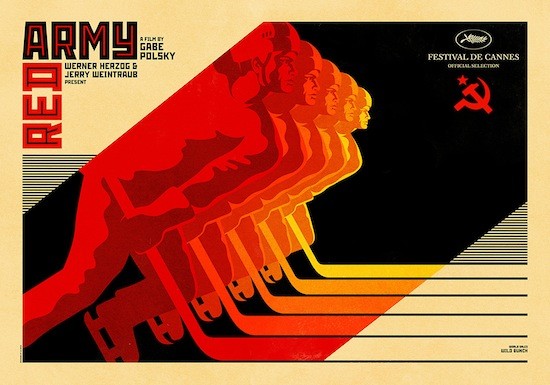
Tampopo (1985; dir. Juzo Itami)—A white-clad gangster and his white-clad moll walk into a movie theater. They take their seats in the front row while their four-man entourage sets up some snacks: cheese, charcuterie, champagne—you know, the usual concessions-counter stuff. But before he has a chance to eat anything, the gangster pauses. He leans forward and gets up out of his seat. Right there in front of him, he’s noticed something interesting. Namely, you. Yes, you—the moviegoer. He sees that you’re at a movie, too. He asks you, “What are you eating?” He starts talking to you about how much it irritates him when other peoples’ snacks make a lot of noise. To prove to you how serious he is about this, the gangster threatens to kill a bespectacled moviegoer behind him whose bag of curry-flavored treats crackle too loudly. Then he returns to his seat. He talks about the final movie—the movie of his life, which will play just before his death. Then the theater grows dark.
You are about to begin watching Juzo Itami’s Tampopo. Relax. Concentrate. Let the world around you fade. Like If on a winter’s night a traveler, Italo Calvino’s great novel about incompletion, possibility, and unfinished stories, Itami’s modern folk tale about one woman’s attempt to cook the perfect bowl of noodles is frequently put on hold to make room for additional food-related footnotes, digressions and vignettes. But instead of distracting from the central plot, these diversions add nuance, grace, and subtlety to perhaps the greatest movie about eating and cooking ever made. Here’s a partial list of that ingredients that comprise this multi-course tasting menu, which are presented with a deadpan panache that dares you to giggle first: erotic games with live prawns and egg yolks, vagabond-gourmet serenades, multiple instances of ramen-based espionage, vacuum-cleaner CPR, life-extending (but not life-saving) family meal preparations, and synchronized chopstick breaking. The film’s triumphant last supper is nearly overshadowed by its final image, a First Supper celebration of sorts that culminates with a minute-long close-up of a baby sucking on his mom’s breast like a champ. Key line: “Let’s review the basic rules of soup.” Grade: A+

Timbuktu (2014; dir. Abderrhamane Sissako)— Sissako’s self-proclaimed “emergency film” about the rise of sharia law in northern Mali was nominated for Best Foreign-Language Film at this year’s Oscars. It lost to another great film, Pawel Pawlikowski’s Ida, but it shouldn’t have. This funny, frightening portrait of a community in crisis is like a North African version of Do The Right Thing set in the desert of the real and equipped with an even more geographically appropriate and politically charged soundtrack. During the last few years I’ve listened to and enjoyed a lot of “desert blues” and Tuareg guitar music—Tinariwen, Terakaft, Bombino, Bassekou Kouyate & Ngoni ba. But the power-ballad poignancy and yearning audible in so many of these bands’ mid-tempo songs take on new cultural significance in Timbuktu, where strumming an oud is punishable by death. The range of human experience and human hypocrisy Sissako records here is wider than the sky, and it’s the humane, fraternal moments among family members and Islamic extremists alike that deepen the film’s central tragedy. Key Question: “Where is God in all this?” Grade: A+

Why Don’t You Play in Hell? (2014; dir. Sion Sono)—Film critic David Ehrlich’s “25 Best Films of 2014” supercut is both an ideal way to commemorate last year at the movies and an inspirational work of criticism-as-art. Although Ehrlich’s short contained dozens of gorgeous scenes and images, one two-second clip stood out: a little girl in a white dress kicking up her heels in a room whose floor is slick with blood as red as a Russian hockey jersey. What kind of movie needed that scene? The question led me to Why Don’t You Play in Hell?, Sion Sono’s fervent, gore-besotted hymn to celluloid film stock, martial-arts choreography, the glories of low-budget moviemaking and the “God of Movies” who inspires the film’s two main gangs—an amateur film crew looking for something to shoot and a yakuza clan whose patriarch is desperate to get his daughter into show business before his wife is released from prison. For Hell’s filmmakers and criminals, life and cinema are identical. They both offer plentiful opportunities to cut a swath through the world with grace, savagery and supreme showmanship. It’s a scene, man, especially towards the end; images of succulent prurience and action-painting volatility are kept from dominating your subconscious only because the TV toothpaste jingle that opens the film has already set up shop there. Key exchange: “Movies don’t kill you.” “Yes, they do.” Grade: A-

Miracle (2004; dir. Gavin O’Connor)—Finally caught up with this strait-laced, eat-your-vegetables, God-Bless-America Disneyfication of the 1980 Olympics’ famous “Miracle on Ice” last Christmas. I live and teach in Minnesota, after all, and Miracle is mandatory viewing for every boys’ and girls’ hockey player in the state. And for years they wouldn’t shut up about how great it was. Well, Slap Shot it ain’t, and more’s the pity. Instead, we get to marvel at Kurt Russell’s grating, nasal Herb Brooks impression, which comes wrapped in some dynamite plaid ensembles that make a bigger emotional impact than anything connected to the starchy batch of interchangeable collegiate stale cookies who (spoiler alert!) band together to take down the Russians in Lake Placid. Still, like any sports fan, I was looking forward to hearing Al Michaels’ broadcast hosannas as the clock wound down and the impossible happened yet again. Michaels’ call is the best part of the whole thing, isn’t it? So how and why did somebody convince him and Ken Dryden to re-record huge chunks of their in-game commentary? The real miracle is that the filmmakers recognized this error and corrected it before it was too late. Key command: “Again!” Grade: C+

Red Army (2014; dir. Gabe Polsky)—While quietly suffering through Miracle’s treacle, I kept wondering about the Russian response to one of sports’ biggest upsets. Now I know, thanks to writer/producer/director Gabe Polsky’s excellent new documentary about the 1980s, the Soviet Union, global hockey dominance as a diplomatic big stick, and free-market capitalism’s role in the decline of team play. Mostly, though, it’s about the five men-not-guys who made up the Red Army team’s famous Green Line, which steamrolled other national teams and a few unfortunate NHL clubs when they weren’t earning Olympic hockey gold in 1984 and 1988. Polsky shows us how they got that way: after taking silver at the 1980 Games, any Russian players who weren’t cut from the team were packed off to a hockey gulag—there were guards at the gate—where they practiced four times a day, eleven months a year for many years. It sounds awful. But it also made them the smoothest and most fearsome unit the modern sport has ever seen. (Or so I’ve been led to believe; I’m more of a basketball guy.) The true adventures of Viacheslav “Slava” Fetisov anchor the film, and his journey from hard-luck kid to rising unpaid superstar to internationally renowned athletic exemplar to Perestroika-era pariah to back-to-back Stanley Cup champion with the Detroit Red Wings (talk about a too-good-to-be true turn of events!) to Minister of Sport in Putin’s Russia is simultaneously hopeful and deeply sad. The gray-haired Fetisov himself is a camera presence who belongs in either a Spaghetti Western or a country bar, where he could still kick a little ass every now and then. Key song lyric: “Cowards don’t play hockey.” Key irony, as spoken by former US Olympic hockey coach Herb Brooks: “Our way of life is the proper way to continue on.” Grade: A-